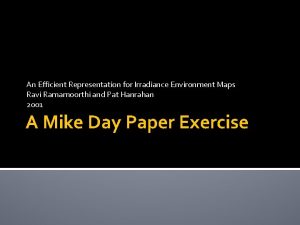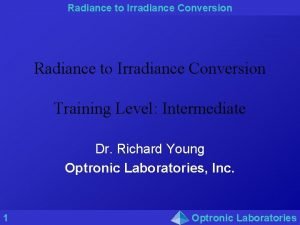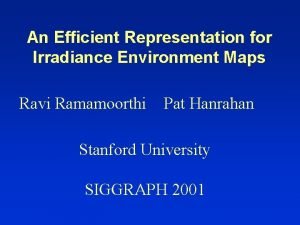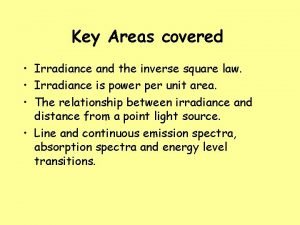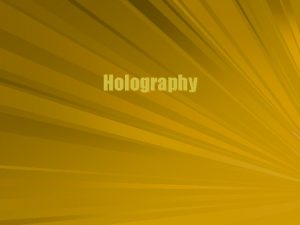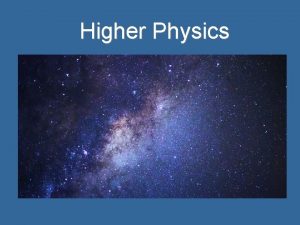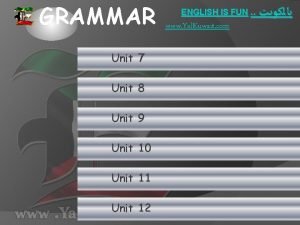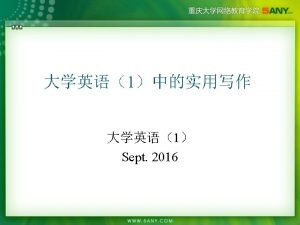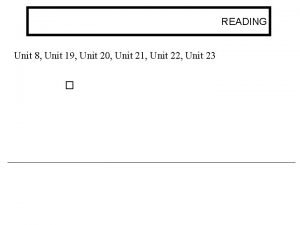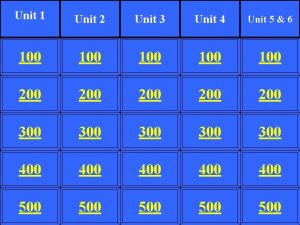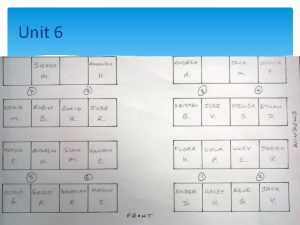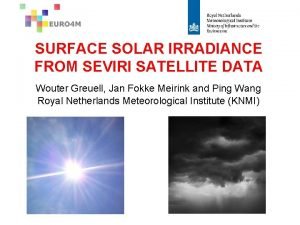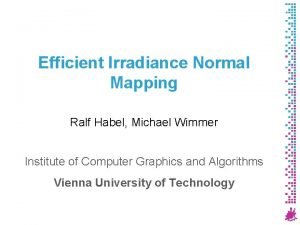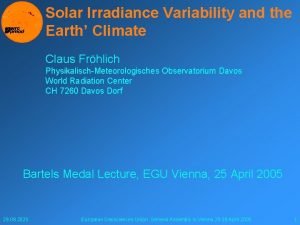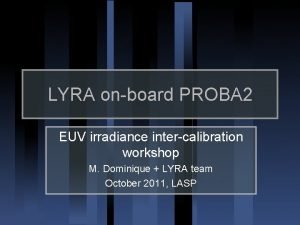IRRADIANCE WHAT IS IRRADIANCE Irradiance is the unit

















- Slides: 17

IRRADIANCE

WHAT IS IRRADIANCE? Irradiance is the unit by which we measure the amount of light falling on an area. In much the same way we might measure the amount of rainfall over Scotland: • If we want to calculate average rainfall we would measure: -The volume or amount of rain -The time over which it fell -The area over which it fell • Irradiance is dealt with in a similar way, you need: -The amount of energy -The time it took for that energy to fall -The area over which it falls

IRRADIANCE Think back to what you know about energy and time… Is there a formula that links them? This leads us to describe irradiance in terms of power per unit area:

IRRADIANCE • Irradiance is measured in watts per metre squared (Wm-2) • It is defined as the amount of energy incident on an area each second. • It can be calculated as: Where I= irradiance (W/ m²) P= power (W) A= area (m²)

EXAMPLE A laser produces 1 k. J of energy in 2 minutes. If it is shone onto a 20 cm by 20 cm piece of card, calculate the irradiance of the laser on the card.

BUT WHAT ABOUT THE DISTANCE? Is irradiance affected by distance? If we consider a source to be a point source, then the light will radiate out equally in all directions. As we get further from the source the same energy is dissipated over a much larger area.

IRRADIANCE AND DISTANCE FROM SOURCE Aim: to find the relationship between irradiance and distance from a light source Equipment: Metre stick Photodiode Voltmeter 12 v bulb Power supply The voltage across the photodiode is directly proportional to the intensity of light incident on it.

IRRADIANCE AND DISTANCE FROM SOURCE Intensity of light I (V) Distance from sources d (cm) 0 10 20 30 40 50 60 70 80 90 d² (m²)

RESULTS: Plot graphs of I against d, I against d² and I against 1/d² Which graph can we draw a relationship from? V (m. V) 1040 600 360 260 160 d (m) 0. 3 0. 4 0. 5 0. 6 0. 8 d² (m²) 1/d² (m¯²)

INVERSE SQUARE LAW EXPERIMENT •

IRRADIANCE & DISTANCE • The Irradiance of a source decreases the further you are from it as the energy is spread over a larger area. • The Irradiance is inversely proportional to the distance squared. • This leads to the equation: (k=constant) • This is known as the Inverse Square Law

INVERSE SQUARE LAW •

EXAMPLE At a distance of 1 m an ultraviolet lamp has an irradiance of 4 W/m². Calculate the irradiance of the same lamp when the distance is doubled.

QUESTIONS Section 7. Spectra: Irradiance & Inverse Square Law Q 1 -5

IRRADIANCE AND PHOTONS •

IRRADIANCE AND PHOTONS •

EXAMPLE Find the number of photons per m² each second if a light beam has an irradiance of 4 W/m² and the photons have a frequency of 4. 5 x 10^14 Hz.
 Irradiance environment map
Irradiance environment map Irradiance to radiance conversion
Irradiance to radiance conversion An efficient representation for irradiance environment maps
An efficient representation for irradiance environment maps Inverse square law irradiance
Inverse square law irradiance Vray global illumination
Vray global illumination Unit 10, unit 10 review tests, unit 10 general test
Unit 10, unit 10 review tests, unit 10 general test Hình ảnh bộ gõ cơ thể búng tay
Hình ảnh bộ gõ cơ thể búng tay Slidetodoc
Slidetodoc Bổ thể
Bổ thể Tỉ lệ cơ thể trẻ em
Tỉ lệ cơ thể trẻ em Voi kéo gỗ như thế nào
Voi kéo gỗ như thế nào Tư thế worms-breton
Tư thế worms-breton Chúa yêu trần thế
Chúa yêu trần thế Các môn thể thao bắt đầu bằng tiếng chạy
Các môn thể thao bắt đầu bằng tiếng chạy Thế nào là hệ số cao nhất
Thế nào là hệ số cao nhất Các châu lục và đại dương trên thế giới
Các châu lục và đại dương trên thế giới Công thức tính độ biến thiên đông lượng
Công thức tính độ biến thiên đông lượng Trời xanh đây là của chúng ta thể thơ
Trời xanh đây là của chúng ta thể thơ
